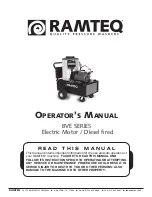
4.1.
ASSEMBLY
4.1.1.
Screw together the two halves of the lance as shown in fig.2. Seal joint by using PTFE tape.
4.1.2.
Slide the rubber cover over the connector nut.
4.1.3.
Attach the high pressure hose to the water inlet on the gun handle as shown in fig.3A and B. Seal joint by using PTFE tape.
4.1.4.
Attach the other end of the high pressure hose to the pump outlet as shown in fig.6. Seal joint by using PTFE tape.
4.1.5. . Connect the mains cold water supply hose to the water inlet as shown in fig.5.
NOTE:
The cold water supply hose must be reinforced and have an
internal diameter of 13mm (1/2”). The minimum water supply
rate must be at least equal to the washer flow rate.
4.2.
DETERGENT DELIVERY fig.6
4.2.1.
On the side of the pump outlet is a brass siphon injection fitting.
4.2.2.
Push the detergent delivery pipe onto the fitting and place the filter on the other end of the pipe into a container of detergent.
4.2.3.
When the nozzle on the lance is set to low pressure, detergent will be drawn from the container by siphonic action and will mix
automatically with the water from the pump. Use Sealey General Purpose Detergent,
AK130 (25ltr)
or
AK131 (5ltr)
. Traffic Film Remover
is also available,
AK132 (25ltr)
or
AK133 (5ltr)
.
4.3.
NOZZLE CONTROL fig.2
4.3.1.
PRESSURE. To change from high pressure to low pressure
the whole nozzle moves backwards and forwards by about 6mm on the end
of the lance. Pull the nozzle back towards the handle for high pressure and push it away from the handle for low pressure (see fig.2).
4.3.2.
SPRAY PATTERN. To change the spray pattern from a
pencil jet to a fan jet rotate the nozzle as shown in fig.4.
4.4.
ENGINE LUBRICATION
4.4.1.
The pressure washer engine is shipped from the factory without oil.
DO NOT
attempt to start the engine before the sump has been filled
with the correct amount of oil. Oil capacity 0.55L, oil grade SAE10W-30. The dip stick is marked L (Low), H (High).
4.5.
FUEL
Fill the petrol tank with fresh unleaded petrol. Tank capacity 1 (one) litre, minimum 87 octane (91 RON).
ON)
4.6.
TEMPERATURE RELIEF VALVE fig.5
4.6.1.
A temperature relief valve is fitted to protect the machine from overheating if the gun remains closed for an extended period of time or if
the nozzle becomes blocked. To prolong the life of the washer every effort should be made to avoid overheating. It is recommended that
if the unit is not to be used for five minutes or more it should be switched off.
4.7.
TRIGGER LOCK fig.3
4.7.1.
To prevent accidental starting of the pressure washer, the trigger can be locked as shown in fig.3.A by hinging out the lever built
into the back of the trigger and pressing it until it snaps into an indent in the handle. To release the locking lever flex the trigger handle
forwards and flip the lever out of the indent and fold it back into the trigger. The trigger should be locked whenever the washer is not in
use.
5. OPERATION
WARNING!
Ensure you read, understand and apply all Section 1 safety instructions.
IMPORTANT
Oil has been drained for shipping. Failure to fill engine with oil before starting engine will result in permanent damage and
will void engine warranty.
WARNING!
Dry running can seriously damage the unit.
fig.4
fig.3
Original Language Version
© Jack Sealey Limited
fig.5
fig.6
PWM1300.V2 Issue 2 (2) 07/12/20


























